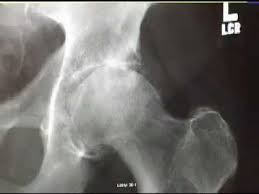Arthritis -What can we do?
Osteoarthritis is a debilitating, progressive degenerative condition of the joints in dogs and cats. Studies show that 1 in 5 dogs suffer from osteoarthritis (OA) in some form and that 80% of geriatric dogs have some OA. It is a slowly progressive disease, that we can do nothing to cure but we do have prevention and management strategies. Your pet may be developing arthritis if they:
- have intermittent lameness
- reluctance to move or rise from sitting
- stiffness and bunny hopping gait
- swollen joints or visible joint deformaties
- painful joints
It is a disease that is best treated early, when the first signs appear.
The critical issues for us, as vets and owners are:
- manage the pain that OA brings
- improve mobility and quality of life
- prevent further progression
Joint supplements
Omega – 3 fatty acids

There is a huge range of joint supplements on the market, of varying types. Ones containing Omega-3 fatty acids have got scientific evidence to back up the claims of providing pain relief and improving mobility. The active ingredients in Omega 3 are EPA and DHA, the amount of these should always be stated on the label of any reputable product you use. The dogs need a combined dose of 310 mg/kg body weight to be effective, but be aware that 370 mg/kg is the upper safe limit. So always dose to your pet’s weight. Dogs cannot get their omega 3 from plant-based products such as flax seed etc, it MUST be marine based. So feeding a human product may not be beneficial at all. It is only effective if the product is processed using a freeze dry or cold processing system.
The easiest was to feed these in the correct dose is to use Hills j/d food https://www.hillspet.com.au/dog-food/pd-jd-canine-dry.
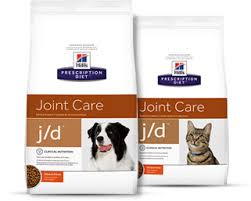
Glyde or Pernaease are also excellent supplements that can be added to your pets food. Look at them here https://www.obay.com.au/index.php?option=com_virtuemart&view=category&virtuemart_category_id=18
Green lipped mussel
This also contains glucosamine and chondroitin, which are excellent as a preventative products. Products containing shark cartilage are not as effective and anything based on bovine cartilage is useless for dogs as it will not gravitate to the joints. These products should be fed as early as possible to agility or performance dogs, or any dogs that are at risk of developing arthritis such as those with patella luxation, cruciate disease or hip dysplasia.
Pernaease is the cheapest most effective format we can find.
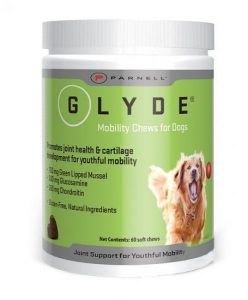
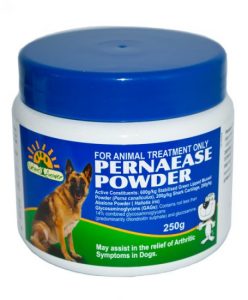
4Cyte
4Cyte is a newer product on the market containing epiliitalis, which is a oil extracted from a pine tree. This is combined with green lipped mussel and omega 3 from abolone. It has been shown to heal any damaged cartilage in joints and stop the progression of OA. It is a bit more expensive than the above products, but in large dogs an equine form can be used to make it more cost effective. It can be used with j/d food.
This is now available in a liquid form that has a great creamy taste. It has a palatability guarantee. If you buy it from us on our recommendation, and you are not happy with the results, then we will refund your money!!
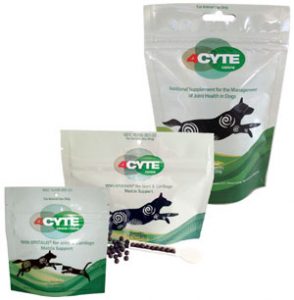
Pentosan injections
Pentosan is a product manufactured from beech wood (how do they find these things?) that has been shown to:
- repair the joint cartilage
- increase the joint fluid
- increase the bl0od flow to the joint.
This decreases pain and stops the progression of the arthritis. It is best given early on in the disease as it is less effective when there are bony changes. It is a course of 4 injections, 1 week apart. The response lasts form between 6-12 months, however sometimes we recommend a booster injection every 3 months. The cost is about $30-$40 per injection. We find this an excellent first line of arthritis defence. It can be used in conjunction with any of the other strategies.
Reduce obesity

If your dog or cat is overweight, the joints are under a greater stress load, ensuring that OA is more likely to be worse. Fat tissue also releases inflammatory products such as interleukin-6, which attack the cartilage of joints, causing OA. So obese animals are more likely to develop OA from that alone. Once they have painful joints, it becomes harder to exercise them which leads to extra weight gain. A vicious circle develops. Any weight loss (even 5-10%) has been shown to have a positive effect. We are happy to do a weigh loss plan for you, just ask our nurses.
Keep them warm
Letting the joints get cold can reduce their mobiltiy so simple tricks like thick bed, and a coat at night will go towards improving your pet’s quality of life. A warm fire doesn’t hurt!
Pain relief tablets
Long term pain relief tablets can have some serious side effects such as gut ulceration and kidney issues, but they are the most common way of OA treatment. So we would not reach for them early in the course of OA. These days there are multiple products we can use, with different modes of action. Most people like to have a few on hand though in case their pet is having a bad day. If one type is not effective, we can change or add different drugs to keep your pet comfortable. In some cases, blood tests may need to be done regularly to monitor liver and kidney function. Common drugs are meloxicam, onsior, carprophen, tramadol.
Rehabilitation
Laser treatment are gaining acceptance as a way of treating the pain and increasing the mobility of OA sufferers.
Water therapy – swimming or if you can, hydrotherapy are an excellent way of treating OA. Not only does it help lose weight (as they can exercise without weight bearing) it improves muscle tome and frees up the joints.
Keeping your pet warm at night – using blankets, coats and thick bedding will also keep your pet more comfortable.
Cannabis for pain relief
Apart from being illegal, studies show that cannabis does not produce any pain relief in non-cancerous pain, so it is not an effective therapy.
Stem cell therapy or platelet rich plasma
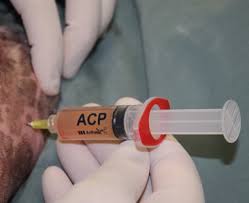
These are still in the experimental phase. There are no developed protocols to produce the products and a great variety in the quality of the the product. They are injected directly into the joints themselves. While specialist vets are not discounting them, do not believe any bold claims about their results. Some pets may get a benefit but it is not a guarantee. They will not work if there is any bony issues with the joints.
Intra articular injections
These are quite common in human and equine medicine, but less so in dogs and cats. A steroid in injected directly into the joint for pain relief, after we have determined that there is no infection already present. They will cause deterioration of the cartilage over time, so they are a last resort option.
Surgery
In some cases, such as severe hip dysplasia or elbow OA, there are surgical options that can be investigated. A specialist surgeon is available in Toowoomba now, so most operations can be performed here. Hip replacements have been around for a while but an exciting development for the future is elbow and knee replacements.
